5V0-41.20 Online Practice Questions and Answers
Scenario 3:
After resolving numerous connectivity issues throughout the various branch sites, connectivity between applications and users is finally present. The network administrator is informed that during certain tests, applications are not performing as they are expected to. Users report that call quality has not fully improved and that some of their calls either drop or have poor voice quality where the conversation is breaking up. Other users are noticing that file transfers are slower than expect. A group of users from a few sites have reported slowness in accessing internal and external applications.
Exhibit.
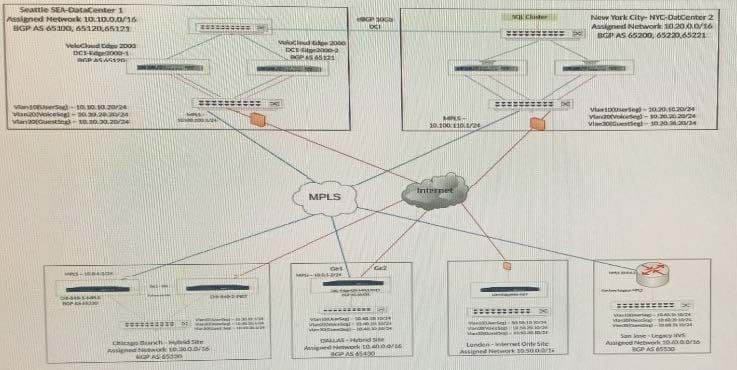
A network administrator wants to achieve better high-availability and network reconvergence between LAN-side BGP Networks and the hub Edges in New York.
What must the administrator do?
A. Modify the Keep Alive and Hold timers to the lowest possible values ensuring the Hold timer is 3 times more than the Keep Alive timer.
B. Nothing, the system will auto-rebalance connections and will provide sub-second convergence.
C. Modify the Connect and Hold timers to the lowest possible values ensuring the Hold timer is 3 times more than the Connect timer.
D. Modify the Keep Alive and Hold timers to the lowest possible values ensuring the Keep Alive timer is 3 times more than the Hold timer.
Scenario 2:
After completing the branch activation activities for all required branches, the administrator attempts to test connectivity between the various branches and between the hubs and branches- The administrator notices a lack of connectivity despite being certain that configurations have been complete. The administrator also observed that several users are reporting intermittent connectivity to some of the applications they are accessing. Other users are reporting no access to these applications. Other users at some of the branches claim they cannot get to certain public resources. The administrator wants to ensure that all sites can talk to each other and all resources are accessible.
Exhibit.
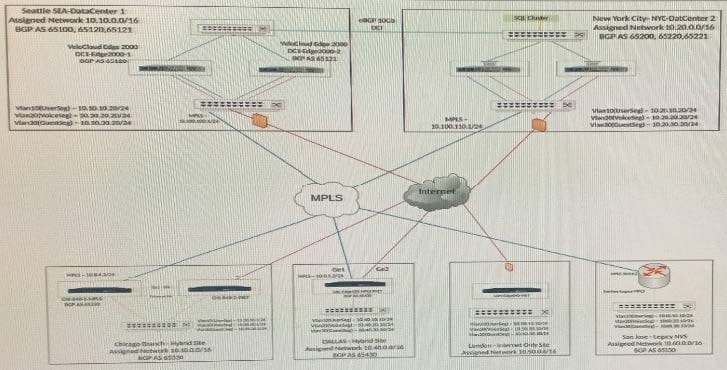
The tunnel from the Dallas site to the Seattle hub is not coming up.
What are two things that should be checked to determine the issue? (Choose two.)
A. Hub WAN Interface might be behind a firewall.
B. Spoke Edge and Hub Edge have a mismatched certificate.
C. Dynamic Branch to Branch is not enabled.
D. Spoke Edge and Hub Edge are two different Edge models.
Scenario 2:
After completing the branch activation activities for all required branches, the network administrator attempts to test connectivity between the various branches and between the hubs and branches. The administrator notices a lack of connectivity despite being certain that configurations have been complete. The administrator also observed that several users are reporting intermittent connectivity to some of the applications they are accessing. Other users are reporting no access to these applications. Other users at some of the branches claim they cannot get to certain public resources. The administrator wants to ensure that all sites can talk to each other and all resources are accessible.
Exhibit.
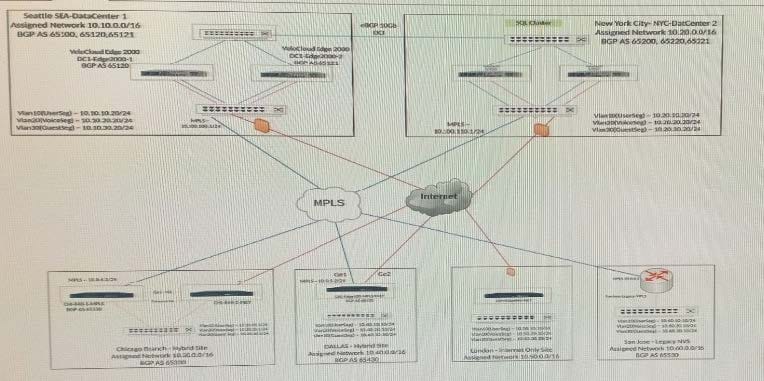
A network administrator has received an email from the applications development team requesting connectivity to their AWS VPC.
The administrator has configured the tunnel via the VMware SD-WAN Gateway. The tunnel status icon has not turned green.
Where are two places the administrator must check? (Choose two.)
A. Determine if the DH parameter on the Edge has been configured.
B. Determine if the PSK is mismatched between the AWS side and the VeloCloud Edge.
C. Determine if the NVS has been enabled and assigned to a profile.
D. Determine if the PSK is mismatched between the AWS side and the VeloCloud Gateway.
Scenario 3:
After resolving numerous connectivity issues throughout the various branch sites, connectivity between applications and users is finally present. The network administrator is informed that during certain tests, applications are not performing as they are expected to. Users report that call quality has not fully improved and that some of their calls either drop or have poor voice quality where the conversation is breaking up. Other users are noticing that file transfers are slower than expect. A group of users from a few sites have reported slowness in accessing internal and external applications.
Exhibit.
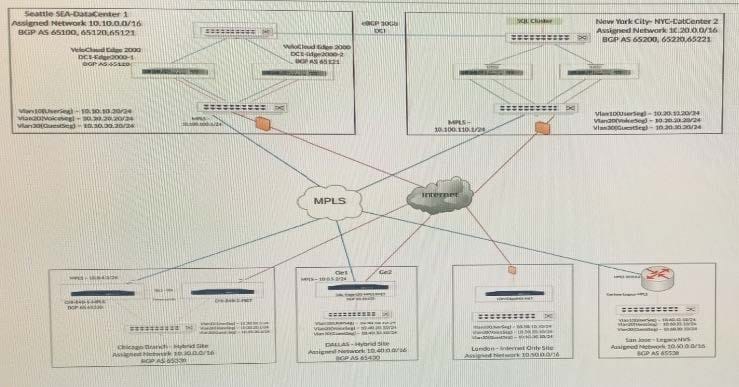
Users at the Dallas Branch are complaining that downloads/uploads from Office365 are slow. Working in Teams has been providing slow responses. The Internet circuit is 100Mbps while the MPLS Circuit is 45Mbps. Upon troubleshooting, the network administrator has noticed the traffic is Backhauling through the Seattle hub for all internet traffic.
How should the network administrator resolve the issue?
A. Leave the system as is, the gateways will resolve the issues after doing 15 minutes of link qualification.
B. Advertise public routes to Office365 and Teams through the New York Hub.
C. Leave the system as is, the hubs will auto-rebalance tunnels after doing 15 minutes of link qualification.
D. Prevent the hub from advertising a default route.
Scenario 1:
A network administrator is tasked! with enabling SO-WAN at three branch locations. A topology has been provided for reference. For each site, the administrator is having issues bringing edges online, as another administrator has gone ahead and created a configuration ahead of time. The organization has several branch sites- One is an Internet- only site and two are Hybrid locations with both internet and MPLS: The last location is MPLS only. There are hub data center locations in this environment as well. Please refer to the topology.
Exhibit.
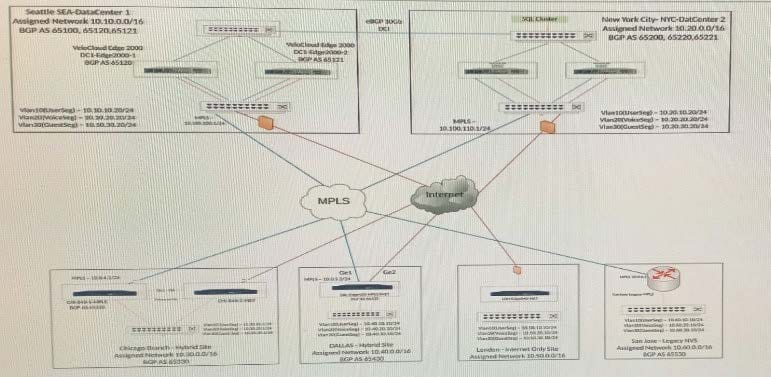
An administrator is attempting to activate two Edge devices at the Chicago branch location. The local technician reports that the Edge devices are not coming online. The Edge devices have been plugged in, powered on, and connected to the correct circuits with an Enhanced HA setup.
What should the local technician check first when troubleshooting the issue?
A. Verify beep sequence of the Edge devices.
B. Review color of the LED.
C. Review the Orchestrator for HA misconfiguration issues.
D. Verify the link light sequence of the HA ports.
Scenario 1:
A network administrator is tasked with enabling SO-WAN at three branch locations. A topology has been provided for reference. For each site, the administrator is having issues bringing edges online, as another administrator has gone ahead and created a configuration ahead of time. The organization has several branch sites. One is an Internet- only site and two are Hybrid locations with both internet and MPLS. The last location is MPLS only. There are hub data center locations in this environment as well. Please refer to the topology.
After the network administrator has determined the problem with the Edge not being able to access the Internet, the administrator receives another error stating that the SD-WAN Orchestrator is still not reachable.
The VCO's address is Amer-vcoOl.velocloud.net.
Refer to the Exhibit(s).
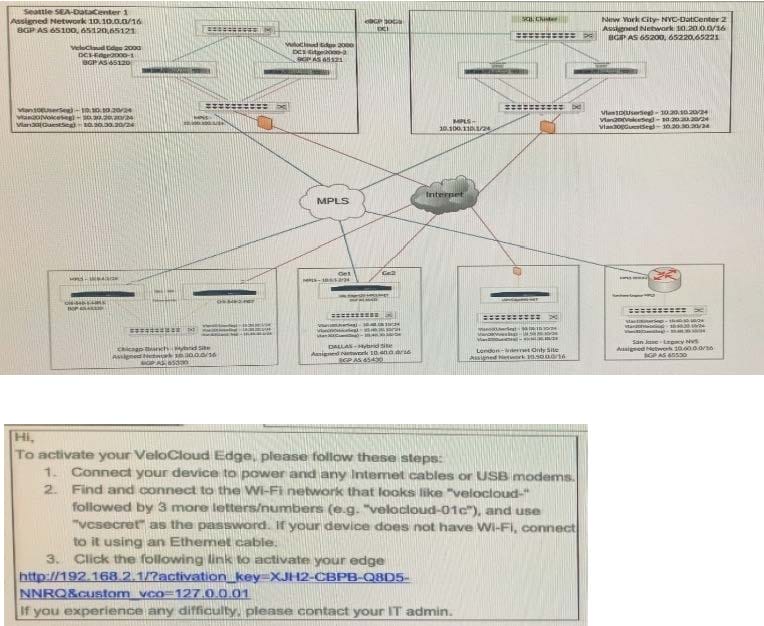
What might be disallowing the Edge to communicate with the Orchestrator?
A. The SD-WAN Orchestrator specified is incorrect, and a new activation email needs to be sent.
B. The local firewall that the Edge uses to reach externally is blocking UDP Port 53 in both directions.
C. The SD-WAN Orchestrator has a limited 60-second window for the Edge to come online.
D. The SD-WAN Orchestrator is not being resolved for DNS.
Scenario 3:
After resolving numerous connectivity issues throughout the various branch sites, connectivity between applications and users is finally present. The network administrator is informed that during certain tests, applications are not performing as they are expected to. Users report that call quality has not fully improved and that some of their calls either drop or have poor voice quality where the conversation is breaking up. Other users are noticing that file transfers are slower than expect. A group of users from a few sites have reported slowness in accessing internal and external applications.
Exhibit.
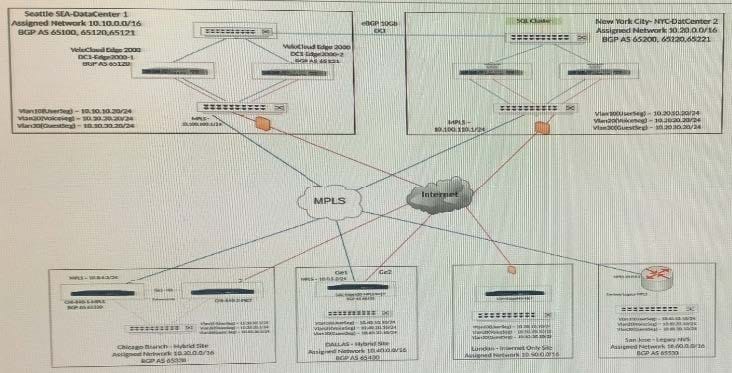
Users at a remote office are complaining about poor performance with certain applications. The network administrator has already configured Business Policies based on these requirements.
What is the sequence of parameters that the administrator can check to troubleshoot this problem? (Choose two.)
A. Change the bandwidth measurement under WAN Overlay Advanced Settings.
B. Check underlay network (bandwidth, latency, jitter, packet loss).
C. Under Monitor, check Routing tab.
D. Review Business Policies configuration and match them against the business requirements.
Scenario 2:
After completing the branch activation activities for all required branches, the network administrator attempts to test connectivity between the various branches and between the hubs and branches. The administrator notices a lack of connectivity despite being certain that configurations have been complete. The administrator also observed that several users are reporting intermittent connectivity to some of the applications they are accessing. Other users are reporting no access to these applications. Other users at some of the branches claim they cannot get to certain public resources. The administrator wants to ensure that all sites can talk to each other and all resources are accessible.
Exhibit.
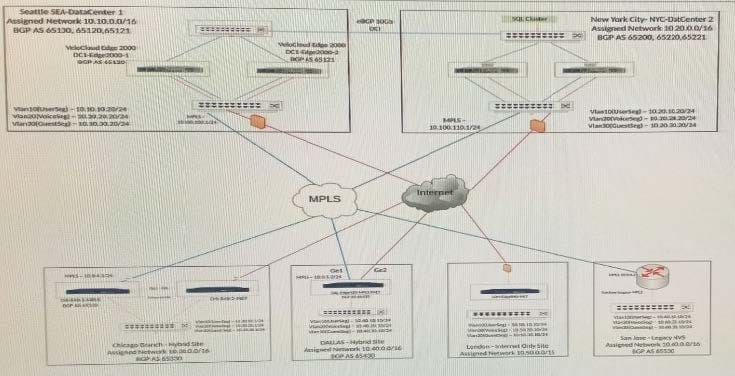
A network administrator is investigating connectivity issues between Chicago and San Jose. The administrator browses to the Overlay Flow Control (OFC) window and notices that the screen is blank with no routes shown in the OFC.
What is a possible reason for this?
A. Cloud VPN for the Edges / Profiles is not enabled.
B. There is an invalid MTU configuration at Chicago.
C. OSPF or BGP is not enabled.
D. The routing table on the Edges has not been initialized.
Scenario 2:
After completing the branch activation activities for all required branches, the network administrator attempts to test connectivity between the various branches and between the hubs and branches. The administrator notices a lack of connectivity despite being certain that configurations have been complete. The administrator also observed that several users are reporting intermittent connectivity to some of the applications they are accessing. Other users are reporting no access to these applications. Other users at some of the branches claim they cannot get to certain public resources. The administrator wants to ensure that all sites can talk to each other and all resources are accessible.
Exhibit.
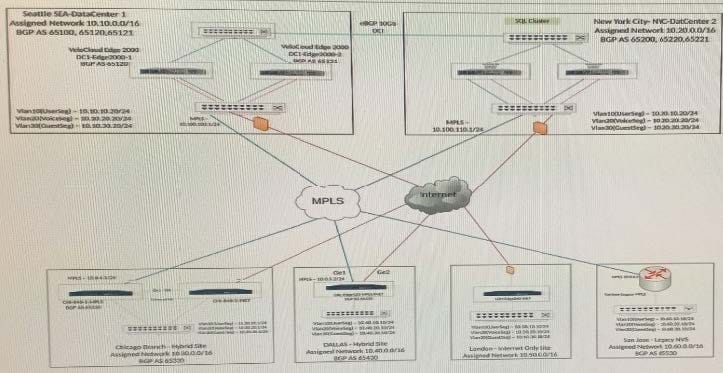
The SD-WAN Edge at this location has been activated. It is incapable of establishing any overlay tunnels. Due to this being an internet only branch, no underlay connectivity is present to the hubs. The SD-WAN Edge is connected behind a firewall and the security team states that all necessary ports are open.
How can this issue be resolved?
A. The security team needs to open TCP port 4500 instead of TCP port 2426.
B. The security team need to open TCP port 2426 outbound but not inbound.
C. The security team needs to open TCP port 22 instead of TCP port 2426.
D. The security team needs to open UDP port 2426 outbound and inbound.
Scenario 2:
After completing the branch activation activities for all required branches, the network administrator attempts to test connectivity between the various branches and between the hubs and branches. The administrator notices a lack of connectivity despite being certain that configurations have been complete. The administrator also observed that several users are reporting intermittent connectivity to some of the applications they are accessing. Other users are reporting no access to these applications. Other users at some of the branches claim they cannot gel to certain public resources. The administrator wants to ensure that all sites can talk to each other and all resources are accessible.
Exhibit.
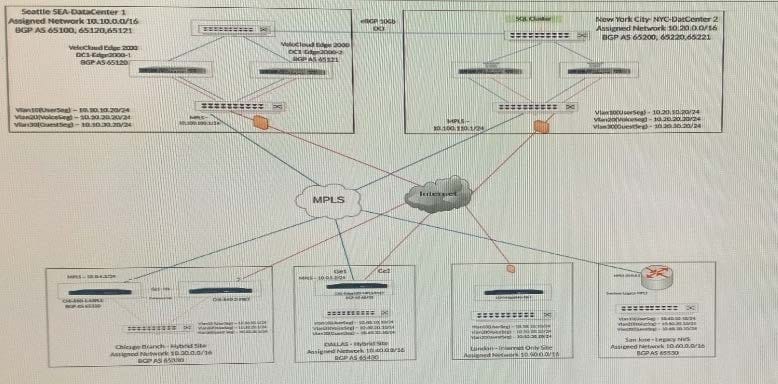
A business policy is created and saved.
How can the network administrator verify the business policy is working?
A. Select a VCE > Test and Troubleshoot > Remote diagnostics and select List Active flows and check the flows to see what Business policy is applied under the Business policy column.
B. Executing Route table dump under VCE > Test St Troubleshoot > Remote Diagnostics and select Route Table dump and look for business policy applied in the Route table Dump stats.
C. Check under Monitor > Applications tab and check the listing of applications at the bottom of the screen and the category of the type of traffic there.
D. Check under the Monitor > Business Priority tab for Business policy statistics.
Scenario 3:
After resolving numerous connectivity Issues throughout the various branch sites, connectivity between applications and users is finally present. The network administrator is informed that during certain tests, applications are not performing as they are expected to. Users report that call quality has not fully improved and that some of their calls either drop or have poor voice quality where the conversation is breaking up. Other users are noticing that file transfers are slower than expect. A group of users from a few sites have reported slowness in accessing internal and external applications.
Exhibit.
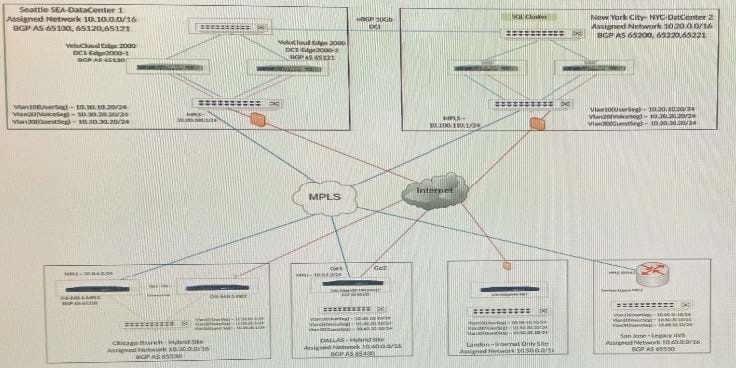
Users at a remote office are complaining about poor performance with certain applications. The network administrator has already verified the configuration is correct.
Which two parameters should the administrator review to troubleshoot this issue? (Choose two.)
A. Check the underlay network (bandwidth, latency, jitter, packet loss)
B. Change the bandwidth measurement under WAN Overlay Advanced Settings
C. Check the flows to verify which Business Policy the traffic of interest is matching
D. Look under Monitor, check Business priority tab
Scenario 2:
After completing the branch activation activities for ail required branches, the network administrator attempts to test connectivity between the various branches and between the hubs and blanches. The administrator notices a lack of connectivity despite being certain that configurations have been complete. The administrator also observed that several users are reporting intermittent connectivity to some of the applications they are accessing. Other users are reporting no access to these applications. Other users at some of the branches claim they cannot get to certain public resources. The administrator wants to ensure that all sites can talk to each other and all resources are accessible.
Exhibit.
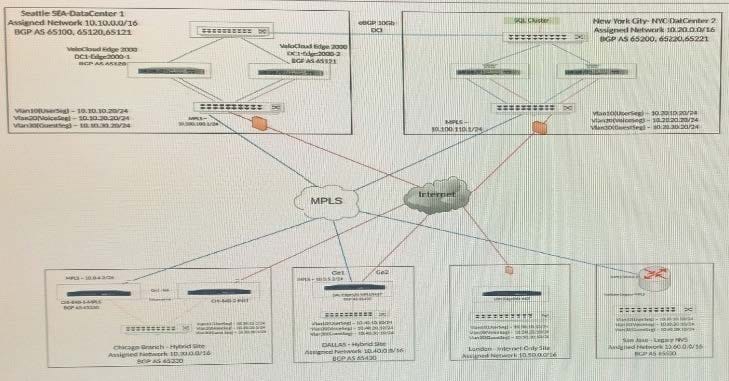
After deploying the Edge, the security team has determined that traffic from Guest wireless traffic is able to reach resources in the Production network. There should be absolutely no interaction.
How can this be prevented?
A. Create an additional segment for Guest wireless traffic and leave the Production traffic in the default global segment.
B. Segmentation is currently not supported on VeloCloud Edge.
C. Create two subnets, one for Guest wireless traffic and another one for Production traffic.
D. Have Guest wireless and Production traffic in the same segment but different VLANs.
Scenario 2:
After completing the branch activation activities for all required branches, the network administrator attempts to test connectivity between the various branches and between the hubs and branches. The administrator notices a lack of connectivity despite being certain that configurations have been complete. The administrator also observed that several users are reporting intermittent connectivity to some of the applications they are accessing. Other users are reporting no access to these applications. Other users at some of the branches claim they cannot get to certain public resources. The administrator wants to ensure that all sites can talk to each other and all resources are accessible.
Exhibit.
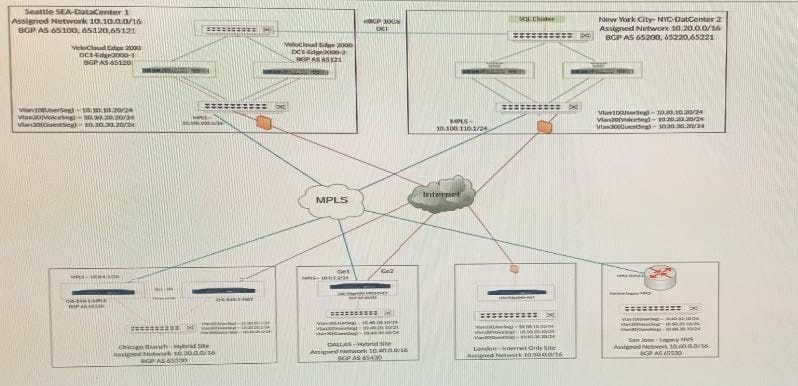
A network administrator is trying to create multiple overlays on a single physical interface on an Edge. The administrator is able to bring up only a single overlay so far, but is having trouble with bringing up additional overlays.
What could be the possible reason?
A. The administrator does not have the right permission to create multiple overlays. The administrator needs to have an Operator-level privilege for this task.
B. On the WAN overlay configuration, verify the IP address, next-hop, and the VLAN ID configuration.
C. The licensing does not support multiple overlays on a single physical interface.
D. Multiple overlays cannot be created on a single physical interface. Multiple physical interfaces are needed.
Scenario 2:
After completing the branch activation activities for all required branches, the network administrator attempts to test connectivity between the various branches and between the hubs and branches. The administrator notices a lack of connectivity despite being certain that configurations have been complete. The administrator also observed that several users are reporting intermittent connectivity to some of the applications they are accessing. Other users are reporting no access to these applications. Other users at some of the branches claim they cannot get to certain public resources. The administrator wants to ensure that all sites can talk to each other and all resources are accessible.
Exhibit.
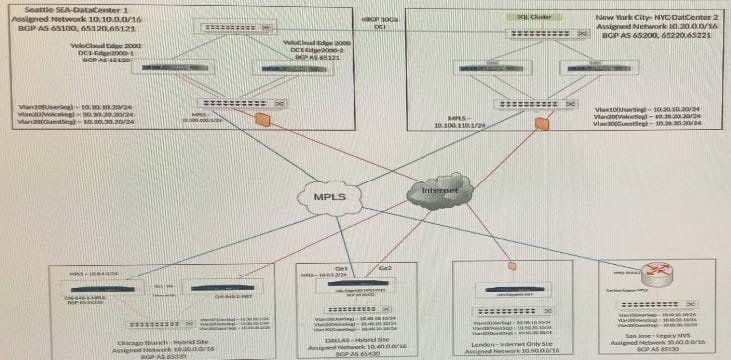
Where can the network administrator check to see what routes are present on the London- site Edge?
A. Log into the VCO > Configuration > Overlay Flow Control
B. Log into the VCO > Test and Troubleshoot > Remote Diagnostics > Run "List Paths"
C. Log into the VCO > Test and Troubleshoot > Remote Diagnostics > Run "Route Table Dump"
D. Log into the VCO > Monitoring > Overlay Flow Control
Scenario:1
A network administrator is tasked with enabling SD-WAN at three branch locations, A topology has been provided for reference. For each site, the administrator is having issues bringing edges online, as another administrator has gone ahead and created a configuration ahead of time. The organization has several branch sites. One is an Internet- only site and two are Hybrid locations with both internet and MPLS. The last location is MPLS only. There are hub data center in this environment as well. Please refer to the topology.
Exhibit.
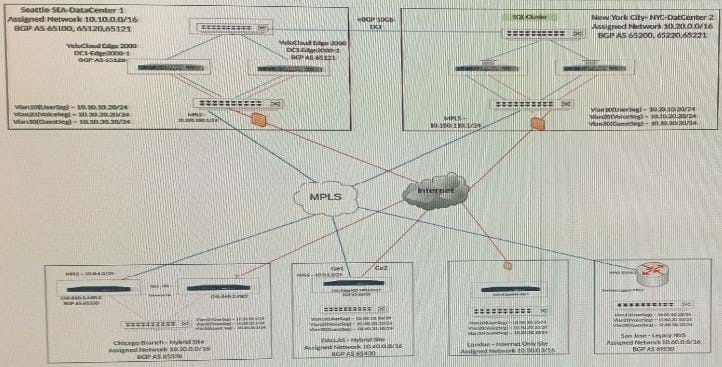
One of the Edges at the Chicago site is unable to activate. The Edge has a red LED. What is the next troubleshooting step?
A. If the Edge is connected to its HA peer, determine if there is a link-light on the HA peer- link.
B. If the Edge is connected to the MPLS circuit, determine if the Hub is advertising gateway routes.
C. If the Edge is connected to the MPLS circuit which does not have DHCP, determine if there is a static IP configuration that needs to be applied upon activation.
D. If the Edge is connected to its HA peer, determine if underlay BGP peering is present between the two Edges.
